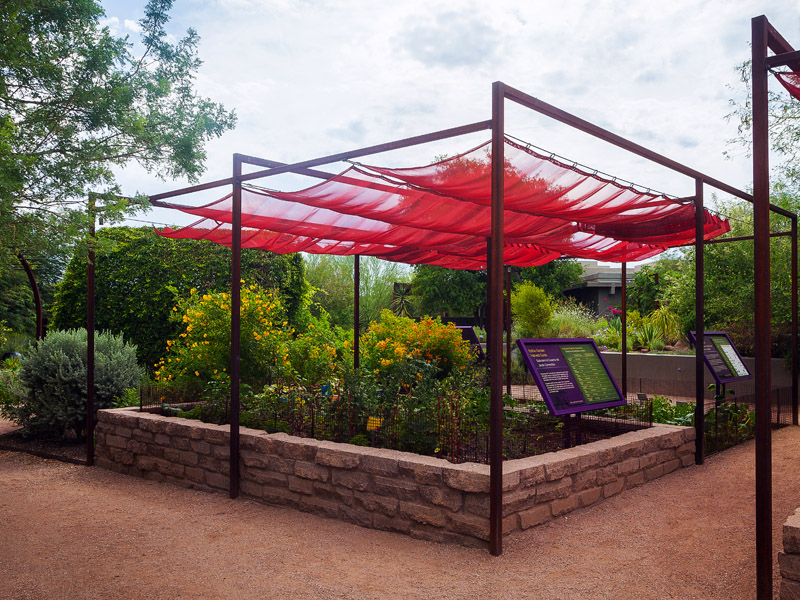The beauty of Desert Botanical Garden expresses itself in special ways on each of its five thematic trails. While the Garden began as a one focused on conserving and celebrating the wonders of Sonoran Desert plants, another worthy mission was soon identified in educating local residents about how to create personal desert oases in their own home gardens.
In 1984, the Rhuart Demonstration Garden made its debut in displaying and teaching low-desert gardening concepts to local gardeners. Planting designs featured herbs, edible beds, flowering perennials and shrubs, and a wealth of other lush, desert-adapted plants hailing not only from the Sonoran Desert but from arid lands worldwide. In 2007, the trail transformed into Steele Herb Garden, focusing on themed planting concepts such as Medicinal, Picante and Sensory Gardens. By 2012, a final renovation made possible by the “Tending the Garden” campaign created the Center For Desert Living (CDL), underscoring the trail’s mission to inspire use of appealing, local landscapes that responsibly manage arid-climate resources. Key concepts include container planting and use of shade and water-harvesting features to optimize garden microclimates.
Today, visitors appreciate CDL for its vibrant foliage, an ever-changing palette of flowering perennials, and the wildlife that populates its shade-dappled beds seeking food and shelter. Our dedicated birders know that CDL is a mandatory stop in their quest. In the warm season, people report encounters with critters ranging from curious hummingbirds to foraging rodents to sleek king snakes. Queens and Monarchs circle the pollinator beds near the enormous Maguey de Pulque (Agave salmiana), depositing eggs on milkweeds (Asclepias sp.), while Giant Swallowtails seek out citrus trees to nourish their caterpillars, which resemble huge bird droppings to uninitiated humans – and, ideally, to predator birds as well.
All along the trail, a variety of hardy shrubs provide food, perches and habitat to wildlife. They delight humans not only visually but often with a dose of aromatherapy. Visitors may be dazzled by sweet scents from wind-blown blossoms of Beebrush (Aloysia sp.), Nacapule Jasmine (Vallesia baileyana), or ‘Sierra Bouquet’ Texas Ranger (Leucophyllum pruinosum ‘Sierra Bouquet’). Massed plantings of rose bush, lavender and scented geraniums evoke the romanticism of more traditional European flower gardens. Showy flowering perennials like Desert Willow (Chilopsis linearis), Mexican Petunia (Ruellia brittoniana) and Mexican Sunflower (Tithonia fruticosa ‘Goldylocks’) attract a steady stream of bird, bee and butterfly visitors.
Techniques for growing fresh food in the desert can be found in CDL, too. Its plantings include a variety of fruit trees–citruses such as Mexican lime, kumquat, Meyer lemon and several orange cultivars; pomes like ‘Anna’ apple and ‘Aravaipa’ quince; pomegranates (including a rare pink-gold variety, ‘Utah Sweet’); and ‘Black Mission’ figs. Raised edible beds show off the year-round food cultivation opportunities that our mild winters and monsoon summers typically provide. These beds also offer a constant supply of popular cooking herbs and spices such as thyme, oregano, marjoram, bay leaves and sage. Even sugar cane stands tall, stockpiling sucrose for its January harvest. Rosemary hedges throughout the trail provide not only evergreen beauty but an endless supply of savory flavor for potatoes, breads and meat.
Beyond education and inspiration, CDL’s plants are simply fun to explore. Seek out the Silk Floss tree (Ceiba insignis) with its conical, prehistoric-looking trunk spikes. Pause to admire fierce Solanum pyracanthos, a distant cousin to tomatoes whose velvety leaves are spiked with huge red thorns. Observe how the Moon Cactus (Harrisia martini) has draped itself like a wig around a mesquite stump. Watch delicate Whirling Butterflies (Gaura lindheimeri) defy gravity with their bobbing flower stems. Say “Allo” to a wide range of exotic Aloes – fancy striped ones (Aloe variegata), healing medicinal ones (Aloe vera aka barbadensis), even 15-foot tall tree varieties like ‘Hercules’. Seek out lush-leaved Pereskia grandifolia, aka rose cactus, a species considered to be an evolutionary link between leafy plants and cactuses. Encourage children to search for a bear, an elephant and a giant bunny, frolicking near the fountain in topiary forms made of dwarf myrtle (Myrtus communis ‘Compacta’).
As a seasonally-variable space, change is CDL’s constant currency. The trail is continually evolving in its ongoing mission to provide a rich source of inspiration, relaxation and education to visitors both from our own community and world-wide.
Visiting with Kids?
With fall quickly approaching, the Steele Herb Garden is a perfect place for your little ones to discover the beauty of the desert through their senses. Guide your children through a sensory experience starting with sounds. Enjoy the sounds of the Herb Garden. Find a quiet shady spot and listen for 10 seconds with your eyes closed. What did you hear?
Now open your eyes and what do you see? Walk around the Herb Garden and see how many different colors you can discover. How many different colors did you see?
Now walk around and find some rose marry or lavender. What does it smell like? Can you find other plants that have strong smells?
